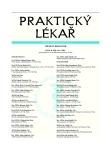Doping in sport and acupuncture
Authors:
E. Radzo
Authors‘ workplace:
Klinika telovýchového lekárstva, fyziatrie a rehabilitácie
; Prednosta: doc. MUDr. Tibor Marček, CSc., mim. prof.
; Lekárska fakulta Univerzity Komenského, Bratislava, Slovensko
Published in:
Prakt. Lék. 2010; 90(12): 718-720
Category:
Various Specialization
Overview
The World Antidoping Agency was established in 1999 to promote drug-free sport and to coordinate and monitor the fight against doping. Society clearly declared its interest in a long-term solution to preventing doping through effective values-based education programs that can foster antidoping behavior and create a strong antidoping culture. Based on current doping reports, athletes prefer to use non-prohibited and OTC medications to boost their athletic performance rather than prohibited ones.
Acupuncture is an interesting method from the point of view of doping. One reason that acupuncture may be added to the list of banned methods may be the potential analgesic mechanism of acupuncture, which is known to be associated with the activation of the endogenous opioid system. Acupuncture and other alternative medicine techniques, used to enhance performance, should be clearly distinguished from the methods with doping potential. For this purpose the existing World Antidoping Agency criteria should be clearly defined for these methods.
Key words:
sport, doping, alternative techniques, acupuncture.
Sources
1. Alaranta, A., Alaranta, H., Helenius, I. Use of prescription drugs in athletes. Sports Med. 2008, 38, p. 449-463.
2. Benedetti, F., Pollo, A., Colloca, L. Opioid-mediated placebo responses boost pain endurance and physical performance: is it doping in sport competitions? J. Neurosci. 2007, 27, p. 11934-11939.
3. Keller, P.A., Lehman, D.R. Designing effective health communication: a metaanalysis. J. Pub. Policy Marketing 2008, 27(2), p. 1-26.
4. Lewis, I.M., Watson, B.C., Tay, R.S., White, K.M. The role of fear appeals in improving. Int. J. Behav. Consult. Ther. 2007, 3(2), p. 203-222.
5. Ma, S.X. Neurobiology of acupuncture: toward CAM. eCAM 2004, 1, p. 41-47.
6. Mason, C. Gold medals, vitamin V and miscreant sports. Can. Med. Assoc. J. 2008, 179(3), p. 219-221.
7. Mazanov, J., Petroczi, A., Holloway, A., Bingham, J. Towards an empirical model of performance enhancing supplement use: A pilot study among high performance UK athletes. J. Sci. Med. Sport 2008, 11, p. 185-190.
8. Perlman, D.H., Bauer, S.M., Ashrafian, K. et al. Mechanistic insights into nitrite-induced cardioprotection using an integrated metabolomic/proteomic approach. Circ. Res. 2009, 104, p. 796-804.
9. Petroczi, A., Aidman, E.V. Psychological drivers in doping: the life-cycle model of performance enhancement. Subst. Abuse Treat. Prev. Policy. 2008, 3, p. 7.
10. Petroczi, A., Naughton, D.P., Mazanov, J. et al. Limited agreement exists between rationale and practice in athletes supplement use for maintenance of health: a retrospective study. Nutr. J. 2007, 6, p. 34.
11. Petroczi, A., Naughton, D.P., Pearce, G. et al. Nutritional supplement use by elite young UK athletes: fallacies of advice regarding efficacy. J. Intl. Soc. Sports Nutr. 2008, 5, p. 22.
12. Petróczi, A., Naughton, D.P. Potentially fatal new trend in performance road safety advertising. Int. J. Behav. Consult. Ther. 2007, 3(2), p. 203-222.
13. Rundell, K.W., Dempsey, W., Uhranowsky, K. Decreased pulmonary artery pressure by oral sildenafil ingestion at mild altitude and during exercise in air pollution increases exercise performance. WADA funded grant proposal 2007 [on-line]. Dostupné na www.wada-ama.org/rtecontent/document/Rundell_07E04KR.pdf.
14. Snyder, L.B. Health communication campaigns and their impact on behavior. J. Nutr. Educ. Behav. 2007, 39(25), S32-S39.
15. Suzic Lazic, J, Dikic, N., Radivojevic, N. et al. Dietary supplements and medications in elite sport-polypharmacy or real need? Scand. J. Med. Sci. Sports 2009, DOI 10.1111/j.1600- 0838.2009.01026.
16. Taioli, E. Use of permitted drugs in Italian professional soccer players. Br. J. Sports Med. 2007, 41, p. 439-441.
17. The 2010 Prohibited list international standard [on-line]. Dostupné na http://www.wada-ama.org/Documents/World_Antidoping_program/WADP-Prohibited-list/WADA_Prohibited_List_2010_EN.pdf.
18. The World Antidoping Agency’s (WADA). WADA Education & Awareness [on-line] Dostupné na http://www.wada-ama.org/en/Education-Awareness.
19. Therapeutic Use Exemptions [on-line]. Dostupné na http://www.wada-ama.org/en/Science-Medicine/TUE/.
20. Viagra® treatment for footballers. BBC News [on-line]. Dostupné na http://news.bbc.co.uk/2/hi/ americas/8005391.stm.
21. Wager, T.D., Scott, D.J., Zubieta, J.K. Placebo effects on human muopioid activity during pain. Proc. Natl. Acad. Sci. USA 2007, 104, p. 11056-11061.
22. World Antidoping Code [on-line]. Dostupné na http://www.wada-ama.org/rtecontent/document/ code_v2009_En.pdf (last accessed date June 13, 2009).
23. World Antidoping Programme [on-line]. Dostupné na http://www.wada-ama.org/en/World-Antidoping-Program.
Labels
General practitioner for children and adolescents General practitioner for adultsArticle was published in
General Practitioner

2010 Issue 12
Most read in this issue
-
Basics of social cognitive and affective neuroscience;
I. Introduction - Regional differentiation of the age structure of practitioners in the Czech Republic at the beginning of the 21st century
- Patient friendly health care for migrants
- Addictive diseases and poverty
